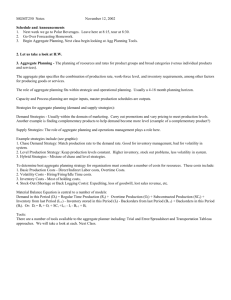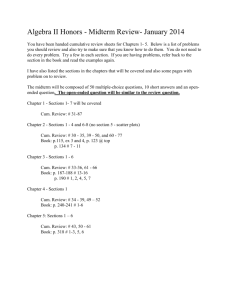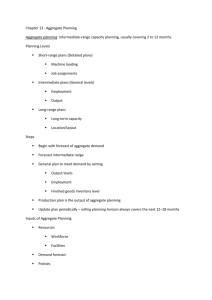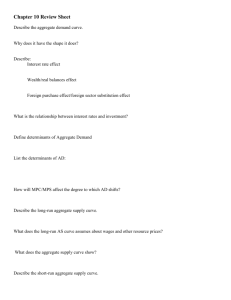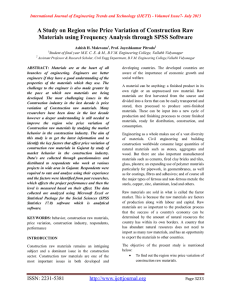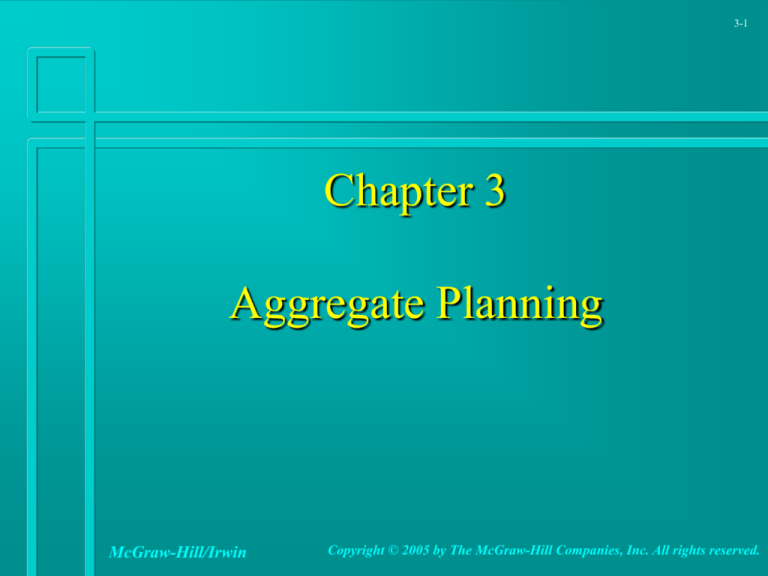
3-1
Chapter 3
Aggregate Planning
McGraw-Hill/Irwin
Copyright © 2005 by The McGraw-Hill Companies, Inc. All rights reserved.
3-2
Introduction to Aggregate Planning
Goal: To plan gross work force levels and set firmwide production plans.
Concept is predicated on the idea of an “aggregate unit”
of production. May be actual units, or may be
measured in weight (tons of steel), volume (gallons of
gasoline), time (worker-hours), or dollars of sales. Can
even be a fictitious quantity. (Refer to example in text
and in slide below.)
The Hierarchy of
Production Planning Decisions
3-3
3-4
Overview of the Problem
Suppose that D1, D2, . . . , DT are the
forecasts of demand for aggregate units
over the planning horizon (T periods.) The
problem is to determine both work force
levels (Wt) and production levels (Pt ) to
minimize total costs over the T period
planning horizon.
3-5
Important Issues
Smoothing. Refers to the costs and disruptions that
result from making changes from one period to the
next.
Bottleneck Planning. Problem of meeting peak demand
because of capacity restrictions.
Planning Horizon. Assumed given (T), but what is
“right” value? Rolling horizons and end of horizon
effect are both important issues.
Treatment of Demand. Assume demand is known.
Ignores uncertainty to focus on the
predictable/systematic variations in demand, such as
seasonality.
3-6
Relevant Costs
Smoothing Costs
– changing size of the work force
– changing number of units produced
Holding Costs
– primary component: opportunity cost of investment
Shortage Costs
– Cost of demand exceeding stock on hand. Why
should shortages be an issue if demand is known?
Other Costs: payroll, overtime, subcontracting.
Cost of Changing
the Size of the Workforce
3-7
3-8
$ Cost
Holding and Back-Order Costs
Slope =
Ci
Slope =
CP
Back-orders
inventory
Positive
Inventory
3-9
Aggregate Units
The method is based on notion of aggregate
units. They may be
Actual units of production
Weight (tons of steel)
Volume (gallons of gasoline)
Dollars (Value of sales)
Fictitious aggregate units
Example of fictitious aggregate units.
(Example 3.1)
3-10
One plant produced 6 models of washing machines:
Model
# hrs.
Price
% sales
A 5532
4.2
285
32
K 4242
4.9
345
21
L 9898
5.1
395
17
L 3800
5.2
425
14
M 2624
5.4
525
10
M 3880
5.8
725
06
Question: How do we define an aggregate unit here?
3-11
Example continued
Notice: Price is not necessarily proportional
to worker hours (i.e., cost): why?
One method for defining an aggregate unit:
requires: .32(4.2) + .21(4.9) + . . . + .06(5.8)
= 4.8644 worker hours. Forecasts for
demand for aggregate units can be obtained
by taking a weighted average (using the
same weights) of individual item forecasts.
Prototype Aggregate Planning Example
(this example is not in the text)
The washing machine plant is interested in
determining work force and production
levels for the next 8 months. Forecasted
demands for Jan-Aug. are: 420, 280, 460,
190, 310, 145, 110, 125. Starting inventory
at the end of December is 200 and the firm
would like to have 100 units on hand at the
end of August. Find monthly production
levels.
3-12
Step 1: Determine “net” demand.
3-13
(subtract starting inv. from per. 1 forecast and add ending inv.
to per. 8 forecast.)
Month
1(Jan)
2(Feb)
3(Mar)
4(Apr)
5(May)
6(June)
7(July)
8(Aug)
Net Predicted
Demand
220
280
460
190
310
145
110
225
Cum. Net
Demand
220
500
960
1150
1460
1605
1715
1940
Days
22
16
23
20
21
17
18
10
3-14
Step 2. Graph Cumulative Net Demand
to Find Plans Graphically
3-15
2000
1800
1600
1400
1200
Cum Net Dem
1000
800
600
400
200
0
1
2
3
4
5
6
7
8
3-16
Constant Work Force Plan
Suppose that we are interested in
determining a production plan that doesn’t
change the size of the workforce over the
planning horizon. How would we do that?
One method: In previous picture, draw a
straight line from origin to 1940 units in
month 8: The slope of the line is the number
of units to produce each month.
3-17
Constant Workforce Plan (zero ending inv)
2000
1500
1000
500
0
1
2
3
4
5
6
7
8
Monthly Production = 1940/8 = 242.2 or rounded to
243/month.
But: there are stockouts.
3-18
How can we have a constant work force plan
with no stockouts?
Answer: using the graph, find the straight line that goes
through the origin and lies completely above the
cumulative net demand curve:
Constant Work Force Plan With No Stockouts
3000
2500
2000
1500
1000
500
0
1
2
3
4
5
6
7
8
From the previous graph, we see that cum. net demand curve3-19
is crossed at period 3, so that monthly production is 960/3 =
320. Ending inventory each month is found from:
Month
Cum. Net. Dem.
1(Jan)
220
2(Feb)
500
3(Mar)
960
4(Apr.)
1150
5(May)
1460
6(June)
1605
7(July)
1715
8(Aug)
1940
Cum. Prod.
320
640
960
1280
1600
1920
2240
2560
Invent.
100
140
0
130
140
315
525
620
But - may not be realistic for several
reasons:
It may not be possible to achieve the
production level of 320 unit/month with an
integer number of workers
Since all months do not have the same
number of workdays, a constant production
level may not translate to the same number
of workers each month.
3-20
3-21
To overcome these shortcomings:
Assume number of workdays per month is
given
K factor given (or computed) where
K = # of aggregate units produced by one
worker in one day
3-22
Finding K
Suppose that we are told that over a period
of 40 days, the plant had 38 workers who
produced 520 units. It follows that:
K= 520/(38*40) = 0.3421
= average number of units produced by
one worker in one day.
3-23
Computing Constant Work Force
Assume we are given the following # of
working days per month: 22, 16, 23, 20, 21,
17, 18, 10. March is still critical month.
Cum. net demand thru March = 960. Cum #
of working days = 22+16+23 = 61. Find
960/61 = 15.7377 units/day implies
15.7377/.3421 = 46 workers required.
3-24
Constant Work Force Production Plan
Mo
Jan
Feb
Mar
Apr
May
Jun
Jul
Aug
# wk days
22
16
23
20
21
22
21
22
Prod. Cum Cum Net End Inv
Level Prod Dem
346
346
220
126
252
598 500
98
362
960
960
0
315
1275 1150
125
330
1605 1460
145
346 1951 1605
346
330
2281 1715
566
346 2627 1940
687
3-25
Addition of Costs
Holding Cost (per unit per month): $8.50
Hiring Cost per worker: $800
Firing Cost per worker: $1,250
Payroll Cost: $75/worker/day
Shortage Cost: $50 unit short/month
3-26
Cost Evaluation of Constant Work Force Plan
Assume that the work force at end of Dec was 40.
Cost to hire 6 workers: 6*800 = $4800
Inventory Cost: accumulate ending inventory:
(126+98+0+. . .+687) = 2093. Add in 100 units netted
out in Aug = 2193. Hence Inv. Cost =
2193*8.5=$18,640.50
Payroll cost:
($75/worker/day)(46 workers )(167days) = $576,150
Cost of plan: $576,150 + $18,640.50 + $4800 =
$599,590.50 ~ $600K
3-27
Cost Reduction in Constant Work Force Plan
In the original cum net demand curve, consider making
reductions in the work force one or more times over the
planning horizon to decrease inventory investment.
Plan Modified With Lay Offs in March and May
2000
1500
1000
500
0
1
2
3
4
5
6
7
8
3-28
Cost Evaluation of Modified Plan
I will not present all the details here. The
modified plan calls for reducing the
workforce to 36 at start of April and making
another reduction to 22 at start of June. The
additional cost of layoffs is $30,000, but
holding costs are reduced to only $4,250.
The total cost of the modified plan is
$467,450.
3-29
Zero Inventory Plan (Chase Strategy)
Here the idea is to change the workforce each
month in order to reduce ending inventory to
nearly zero by matching the workforce with
monthly demand as closely as possible. This is
accomplished by computing the # units produced
by one worker each month (by multiplying K by
#days per month) and then taking net demand each
month and dividing by this quantity. The resulting
ratio is rounded up and possibly adjusted
downward.
3-30
I got the following for this problem:
Period
1
2
3
4
5
6
7
8
# hired
#fired
10
20
9
31
15
24
4
15
Cost of this
plan:
$555,704.50
3-31
Optimal Solutions to Aggregate Planning
Problems Via Linear Programming
Linear Programming provides a means of solving
aggregate planning problems optimally. The LP
formulation is fairly complex requiring 8T
variables and 3T constraints, where T is the length
of the planning horizon. Clearly, this can be a
formidable linear program. The LP formulation
shows that the modified plan we considered with
two months of layoffs is in fact optimal for the
prototype problem.
Refer to the latter part of Chapter 3 and the
Appendix following the chapter for details.


